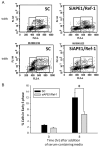Reduced expression of DNA repair and redox signaling protein APE1/Ref-1 impairs human pancreatic cancer cell survival, proliferation, and cell cycle progression
- PMID: 20919954
- PMCID: PMC2966714
- DOI: 10.3109/07357907.2010.512816
Reduced expression of DNA repair and redox signaling protein APE1/Ref-1 impairs human pancreatic cancer cell survival, proliferation, and cell cycle progression
Abstract
Pancreatic cancer is a deadly disease that is virtually never cured. Understanding the chemoresistance intrinsic to this cancer will aid in developing new regimens. High expression of APE1/Ref-1, a DNA repair and redox signaling protein, is associated with resistance, poor outcome, and angiogenesis; little is known in pancreatic cancer. Immunostaining of adenocarcinoma shows greater APE1/Ref-1 expression than in normal pancreas tissue. A decrease in APE1/Ref-1 protein levels results in pancreatic cancer cell growth inhibition, increased apoptosis, and altered cell cycle progression. Endogenous cell cycle inhibitors increase when APE1/ Ref-1 is reduced, demonstrating its importance to proliferation and growth of pancreatic cancer.
Conflict of interest statement
Figures






Similar articles
-
APE1/Ref-1 regulates STAT3 transcriptional activity and APE1/Ref-1-STAT3 dual-targeting effectively inhibits pancreatic cancer cell survival.PLoS One. 2012;7(10):e47462. doi: 10.1371/journal.pone.0047462. Epub 2012 Oct 19. PLoS One. 2012. PMID: 23094050 Free PMC article.
-
Regulation of HIF1α under Hypoxia by APE1/Ref-1 Impacts CA9 Expression: Dual Targeting in Patient-Derived 3D Pancreatic Cancer Models.Mol Cancer Ther. 2016 Nov;15(11):2722-2732. doi: 10.1158/1535-7163.MCT-16-0253. Epub 2016 Aug 17. Mol Cancer Ther. 2016. PMID: 27535970 Free PMC article.
-
Ape1 regulates WNT/β-catenin signaling through its redox functional domain in pancreatic cancer cells.Int J Oncol. 2015 Aug;47(2):610-20. doi: 10.3892/ijo.2015.3048. Epub 2015 Jun 12. Int J Oncol. 2015. PMID: 26081414
-
The DNA base excision repair protein Ape1/Ref-1 as a therapeutic and chemopreventive target.Mol Aspects Med. 2007 Jun-Aug;28(3-4):375-95. doi: 10.1016/j.mam.2007.04.005. Epub 2007 May 3. Mol Aspects Med. 2007. PMID: 17560642 Review.
-
Inhibitors of nuclease and redox activity of apurinic/apyrimidinic endonuclease 1/redox effector factor 1 (APE1/Ref-1).Bioorg Med Chem. 2017 May 1;25(9):2531-2544. doi: 10.1016/j.bmc.2017.01.028. Epub 2017 Jan 21. Bioorg Med Chem. 2017. PMID: 28161249 Review.
Cited by
-
Redox regulation of apurinic/apyrimidinic endonuclease 1 activity in Long-Evans Cinnamon rats during spontaneous hepatitis.Mol Cell Biochem. 2014 Mar;388(1-2):185-93. doi: 10.1007/s11010-013-1909-y. Epub 2013 Dec 15. Mol Cell Biochem. 2014. PMID: 24337968 Free PMC article.
-
Real-Time, Light-Activated, and Multiplexed Monitoring of Base Excision Repair in Living Cells Using Chimeric d/l-DNA Molecular Beacons.ACS Sens. 2025 Aug 22;10(8):5655-5663. doi: 10.1021/acssensors.5c00730. Epub 2025 Aug 4. ACS Sens. 2025. PMID: 40757433 Free PMC article.
-
Antitumor Activity and Mechanistic Characterization of APE1/Ref-1 Inhibitors in Bladder Cancer.Mol Cancer Ther. 2019 Nov;18(11):1947-1960. doi: 10.1158/1535-7163.MCT-18-1166. Epub 2019 Aug 14. Mol Cancer Ther. 2019. PMID: 31413178 Free PMC article.
-
Association between apurinic/apyrimidinic endonuclease 1 rs1760944 T>G polymorphism and susceptibility of cancer: a meta-analysis involving 21764 subjects.Biosci Rep. 2019 Dec 20;39(12):BSR20190866. doi: 10.1042/BSR20190866. Biosci Rep. 2019. PMID: 31804681 Free PMC article.
-
Inhibition of APE1/Ref-1 for Neovascular Eye Diseases: From Biology to Therapy.Int J Mol Sci. 2021 Sep 24;22(19):10279. doi: 10.3390/ijms221910279. Int J Mol Sci. 2021. PMID: 34638620 Free PMC article. Review.
References
-
- Moore MJ. Chemotherapy in pancreatic carcinoma. Current Oncol. 2003;5:s24–s26.
-
- Evans AR, Limp-Foster M, Kelley MR. Going APE over ref-1. Mutat Res. 2000;461:83–108. - PubMed
MeSH terms
Substances
Grants and funding
LinkOut - more resources
Full Text Sources
Other Literature Sources
Medical
Research Materials
Miscellaneous
